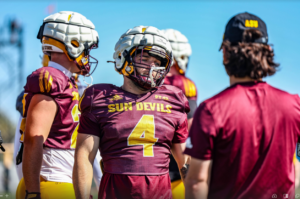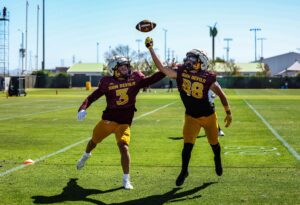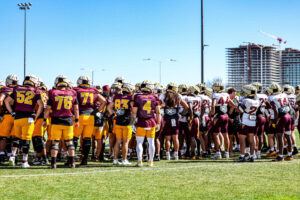- Slug: Sports-Football Guardian Cap, 1,620 words.
- 3 photos available.
By Patrick Holleron
Cronkite News
PHOENIX – When Erin and Lee Hanson were creating Guardian Sports in 2011, their son Jake Hanson was playing middle school football. Like all parents, the Hansons were concerned about the serious injuries that come with playing the physical sport.
The injury they feared most was concussions, which occur after athletes take hits to the head area. The Hansons’ apprehension mostly was due to the uncertainty and lack of information regarding concussions at the time.
This concern added more motivation behind the innovation of Guardian Sports, which aims to create equipment that will protect athletes and change how they play sports. The Hansons’ prior experience in the material science and technology industry led to the creation of the Guardian Cap.
The Guardian Cap is a soft-shell cover made to wrap around the top of a helmet to reduce the force of impact from collisions that are generated in physical contact sports such as football and lacrosse.
“The Hanson family at the time asked themselves ‘Well, we can’t come up with a new helmet, so what can we do to get something that helps reduce impact right away?’” Guardian sales manager Tony Plagman said. “So they came up with an affordable version of the one-size-fits-all helmet. The helmet has additional padding to address the impacts that are happening during practices.”
The cap gained national attention in 2012 when Clemson University announced that athletes who play high-contact football positions such as linebacker or lineman would be required to wear the cap in practice. Since then, more than 200 colleges and 2,000 high schools have used the helmet.
The Guardian Caps eventually made their way to the NFL in 2020 with the Jacksonville Jaguars becoming the first team to use the caps in practices. Initial takeaways from the Jaguars’ use of the caps showed that players who play offensive and defensive line positions are more prone to picking up injuries in the head area in practices rather than games.
Judy Battista, an NFL.com senior national columnist, reported in March that the NFL officially mandated Guardian Caps for all training camp, preseason, regular season, and postseason practices involving contact.
Since then, the caps’ usage between 2020 to the present day have shown reduced concussion cases, according to an NBC interview in August with Jeff Miller, the NFL executive vice president of player health and safety. Miller said players who played positions that required the Guardian Caps experienced a 52% decrease in concussions compared to the previous three offseasons when the caps weren’t being used on a regular basis.
While the reduced concussion cases have been encouraging, players who wear the caps in all levels of football have expressed mixed feelings about them.
“Players who I know have not been a fan of the caps at all,” Arizona Cardinals tackle Kelvin Beachum Jr. said. “I want to know why players had no say in the design of the caps. We weren’t even allowed to beta test them before the league made it mandatory. I don’t know a player in my locker room that is eager and looks forward to wearing them on a weekly basis.”
Beachum isn’t the only professional player to voice his displeasure with the caps. Seattle Seahawks tight end Noah Fant stated to reporters in 2022 that the caps are bulky and that the straps get in the way of his facemask.
On the other side, players from Pinnacle High School in Phoenix voiced strong support of the caps.
“From my perspective, I think we have only had maybe one or two concussions this year in total out of the offensive and defensive linemen,” Pinnacle senior offensive lineman Krush Showers said. “And those concussions didn’t even come from practice. When wearing them, I feel safer. When we were going harder in practice at some points I felt less beat up. Sometimes before we were using them, my head would hurt a little bit here and there, if I got hit the wrong way.”
Among retired football players, the view on Guardian Caps is a bit more neutral. Former offensive lineman Marcel Morris played for Penn State before the team began using the Guardians Caps.
“I think the caps help because you get the added research or the added data to at least know what they can do versus what they can’t,” Morris said. “When you’re taking those big hits, they add up over time. It’s definitely a benefit compared to when we didn’t have anything.”
The caps could prove vital to further protecting players with a prior history of concussions such as Miami Dolphins quarterback Tua Tagaviola. Last Thursday in a game against the Buffalo Bills, Tagaviola suffered his fourth concussion in the past two years. The Dolphins placed Tagaviola on injured reserve for the second time in less than two years.
Coaches who have seen the caps up close have differing views on the benefits they can offer. In 2022, New York Jets coach Robert Saleh told ESPN’s Rich Cimini that the caps could create a misleading feeling of safety. Saleh further explained that players who wear the caps could favor the use of their helmets more in games.
“Some people are hesitant because they think it’s going to add a false sense of security,” Plagman said. “Or they believe that ‘my guys are going to hit harder,’ but luckily the caps are really lightweight. Every player that seems to be interviewed in a news article, or something like that says something along the lines of ‘I forget it’s there.’ And that’s our goal.”
Pinnacle football coach Dana Zupke initially was concerned the material of the Guardian Caps might be an issue for his players.
“I was worried about the friction coefficient of the caps,” Zupke said. “Football helmets have a smooth surface and when you take a shot you want that blow to glance off. The material on the Guardian cap is actually really slick, which surprised me. That was my personal safety concern with the Guardian Caps, the cap might catch onto something potentially causing a rotational force to the neck.
“After seeing them in use, I haven’t observed that.”
Zupke isn’t the first person to have fears about the caps leading to neck injuries. In 2021, ESPN staff writer David Newton talked to Dr. Katherine Breedlove who stated that the results from her 2017 independent study showed the risk of neck injury was low.
“A big concern is always, does it increase risk of neck injury?” Plagman said. “We’ve done testing to make sure that we’re not adding any additional risk in neck injury. It was a huge concern because it is adding a little bit of weight to the head. Luckily, with our attachment method, since it’s not locked down to the helmet, there’s independent movement with those elastic straps that slide through the face mask.”
Other people involved in the sports medicine field are more skeptical of how effective the caps are in reducing concussions.
“It’s my ultimate belief that the brain is surrounded in cerebrospinal fluid,” Veritas Prep athletic trainer Robb Lewis said. “So no matter what kind of shell you put around the brain, it’s still going to slosh around because it’s in fluid. So truly the only way to really stop a concussion would be to harden the fluid somehow around the brain so it doesn’t move and get the impact.
“The caps are not something I truly 100 percent would buy into right now, but they are improving player safety and I would definitely say that they’re on the right path.”
A Stanford University study pointed out that the caps do not protect players from hits in the face guard area. While the study found that the caps could reduce the chances of players getting concussions, the caps have not shown any protection against chronic traumatic encephalopathy, or CTE. CTE is a condition caused by repeated hits and blows to the head area that gets progressively worse over time.
The study raises some legitimate safety concerns of how much the caps can improve players’ health. With that said, the Guardian Caps were never designed to prevent CTE or concussions altogether.
“I would say there’s some in the sports medicine field that think we’re pushing a kind of a magic pill that has concussion prevention, which is something we try really hard to stay away from,” Plagman said.
While the caps are not meant to be the ultimate solution, they have displayed positive trends in reducing concussions. This development led to the NFL approving the use of Guardian Caps in regular season games for this season.
Given all the possible benefits the Guardian Caps can offer for players, one has to wonder why it took this long for the caps to be used in live football games? One reason could be cosmetic.
“The look and feeling of the cap is different,” Plagman said. “The cap actually dulls out noise, so you don’t have that crack of the helmet. Then with bigger high schools, colleges and the NFL, it’s being able to decal them to get the team’s logo on the caps. With the paneling we have right now, the logos don’t look great.”
Players in all levels of football tend to have an issue with the design element of the caps. Former NFL defensive lineman J.J. Watt once likened the appearance to a “beehive on my head.”
Despite a willingness from players such as Indianapolis Colts running back Jonathan Taylor to wear the cap during live football games, there remains resistance to the caps being utilized across the entire league.
“I think changing the game and changing the look of the game,” Plagman said, “is just a really hard thing to do.”
For more stories from Cronkite News, visit cronkitenews.azpbs.org.


